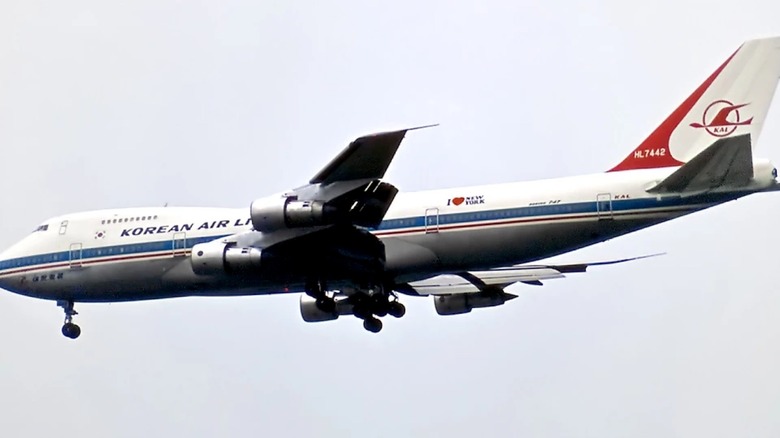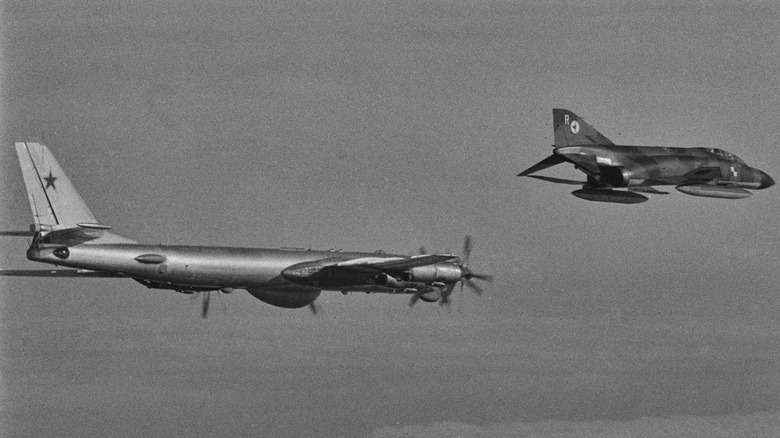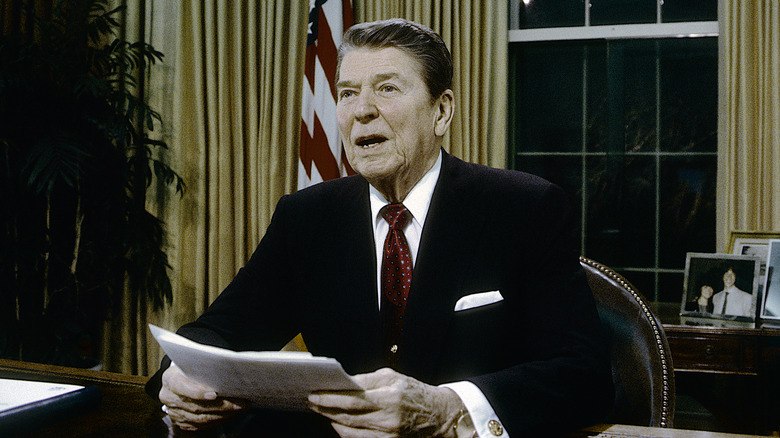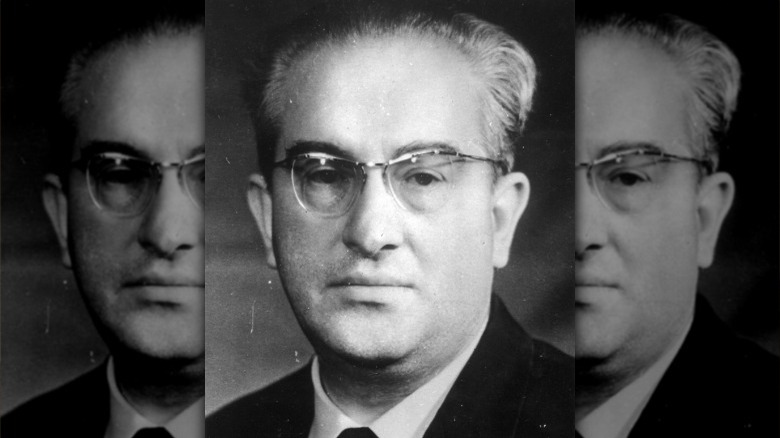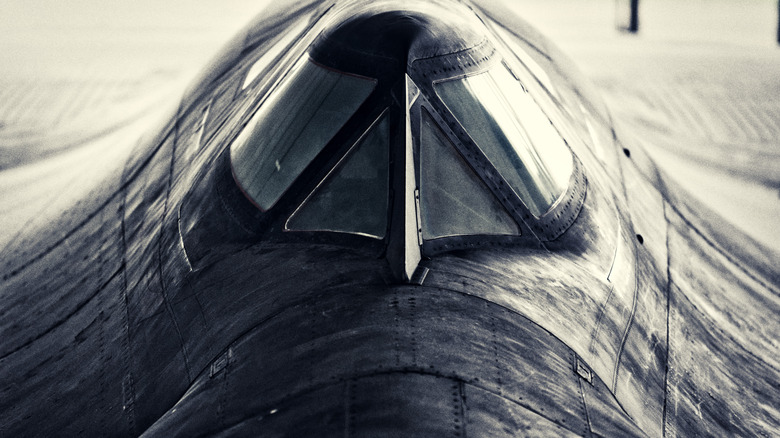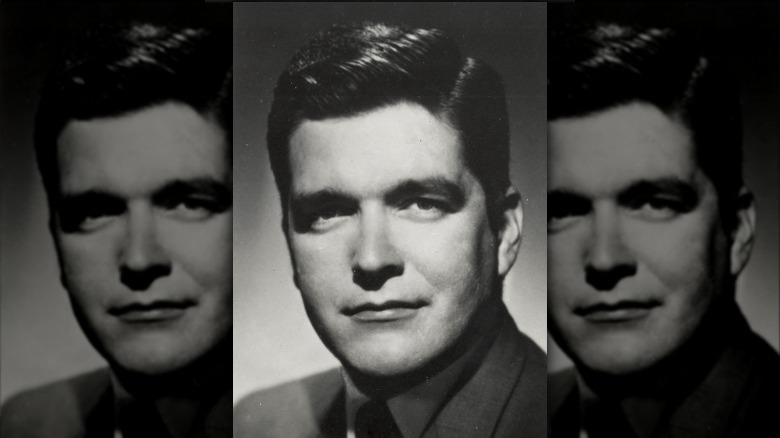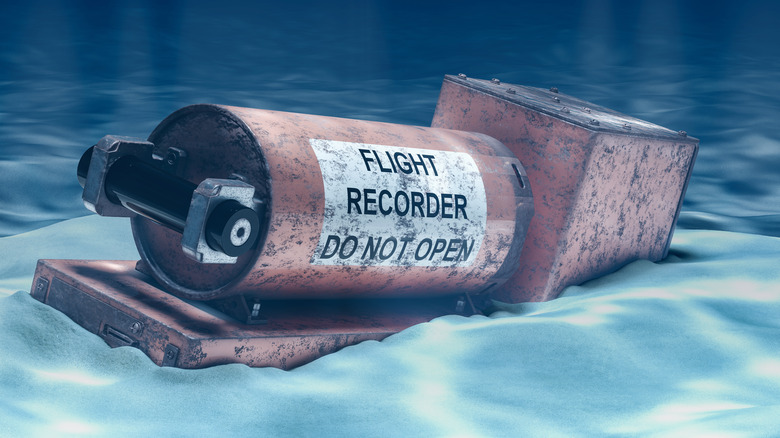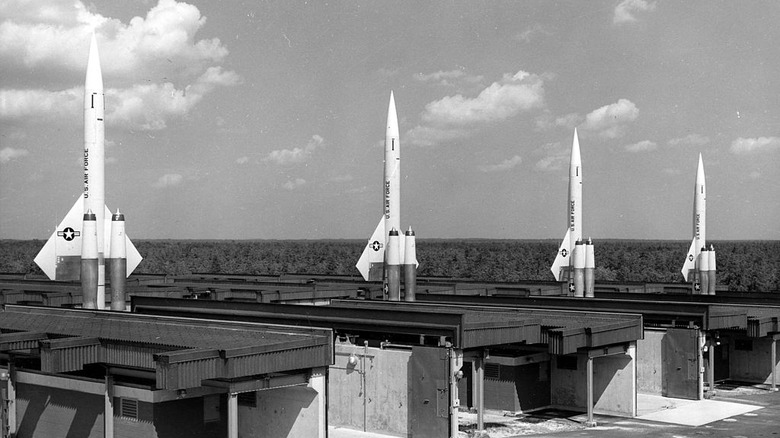The Disastrous Flight Of KAL Flight 007: A Tragedy Of The Cold War
The Cold War was full of tragedies; it's hard to refute that. Between active military confrontations and other incidents that affected civilian populations, there's quite the fair share of grief to go around. Similarly, though, the Cold War also gave rise to no small number of mysteries — the spy missions and gadgets of the time speak for themselves, sounding more like works of fiction than history. Bizarre, unanswered questions are the name of the game when it comes to this time period.
The fate of KAL Flight 007 manages to fit into both of those categories. The deaths of every person on that doomed flight obviously constitute quite the tragedy, but in the time since the plane's crash, more than a few questions have cropped up, as well as just as many strange theories. Why was the plane shot down, and was it intentional or accidental? If it was, in fact, intentional, then what could be the reasons behind it? Or what if the U.S. government had more of a hand in the accident than anyone has ever admitted? Then again, what if it really was just an accident, the result of many unfortunate, compounding circumstances? For a story that initially seems rather straightforward, it's anything but.
[Featured image by Udo K. Haafke via Wikimedia Commons | Cropped and scaled | GFDL 1.2]
The details of KAL Flight 007
Behind all the strange conspiracies and odd coincidences of KAL Flight 007, there's a pretty simple sequence of events. As told by CNN, Korean Air Lines Flight 007 took off from New York's JFK Airport on August 31, 1983, heading to Seoul, South Korea. But it wasn't a direct flight, making a stop in Anchorage, Alaska, before starting the journey across the Pacific Ocean.
And that's where the strange part of the story picks up. Simple Flying adds that the plane was reportedly suffering from some sort of mechanical error, but nonetheless, it was cleared to fly and took off again at 4 a.m. From there, the crew turned on the autopilot, but just 10 minutes into the flight, the plane deviated from its intended course, turning ever so slightly north. It was only a few degrees, but over the next five and a half hours, the plane ended up 200 miles off course. And that was considering that the initial course put the plane's route just 17.5 miles outside of Soviet airspace.
When the plane crossed into Soviet airspace and registered on Soviet radar, four fighter jets were sent to intercept it but failed to make contact. KAL Flight 007 meandered in and out of Soviet airspace a couple times, and Soviet officials couldn't determine whether the plane was civilian or military. The order was given to shoot the plane down, and it flew for about 12 miles before crashing into the sea near Sakhalin Island, presumably killing all 269 people on board.
The situation was pretty confusing
From the outside, the objective facts of the tragedy surrounding KAL Flight 007 seem straightforward. A civilian aircraft veered into Soviet airspace, and fighter jets were scrambled to shoot it down, killing everyone aboard. But that's the benefit of hindsight; at the moment, it was likely more difficult to determine just what was happening.
According to Soviet fighter pilot Gennadi Osipovitch (quoted by CNN), there was a genuine question as to whether or not the aircraft was civilian or military. The windows along the side of the plane and flashing navigational lights made the pilots question what to do, but after signaling to KAL Flight 007 in international code that they'd invaded Soviet airspace, there was no response. Even when the pilots fired warning shots, there was no indication that the other plane would respond. Ultimately, Osipovitch said, "I had no time to think. I had a job to do."
The confusion was only compounded by the fact that there actually was an American spy plane in the general vicinity of KAL Flight 007 on that day. Britannica explains that a U.S. Air Force plane — also a Boeing — was spying on Soviet missile tests in the nearby Kamchatka Peninsula. The Soviets were actively tracking that plane, and it's not hard to imagine that the two were mixed up, especially considering that, at one point, the two planes were within just 75 miles of each other, per Alexander Dallin's ”Black Box: KAL 007 and the Superpowers.”
The U.S. maintained that it was an intentional act of cruelty
Of course, the downing of a civilian aircraft was huge news — that would be true no matter the time period. But considering the backdrop of this event was the Cold War, well, things got especially charged, and U.S. officials were primed to see everything in the worst possible light when it came to the Soviet Union (via The New York Times).
The U.S. House of Representatives' History, Art & Archives compiled just a few of the responses to the tragedy, including Speaker of the House Tip O'Neill's description of the entire thing as "unbelievably barbaric." Another representative said, "It's murder, plain murder." President Ronald Reagan, already famous for calling the Soviet Union an "evil empire," per CNN, also chimed in on the topic, and his comments were, perhaps unsurprisingly, not too flattering. He likened the incident to a massacre and a crime against humanity, summing the whole thing up by saying, "[It had] absolutely no justification, legal or moral."
Strangely enough, though, not all American officials agreed on that point. In fact, as detailed by the Association for Diplomatic Studies and Training (ADST), the situation in South Korea was rather different. Some American diplomats did actually believe that this wasn't some intentional, cruel slaughter of civilians. Rather, they thought that Reagan was purposefully blowing everything out of proportion in order to further his own political ends and sow further anti-Soviet sentiment.
The Soviet Union tried to shirk responsibility
While the rest of the world was responding to news of a massive tragedy, the Soviet Union had a rather different problem on its hands. After all, regardless of anything else, Soviet fighter jets had just shot down a civilian plane. So what were they to do?
Well, to put it simply, according to CNN, they tried to deny that it happened. No word went out about the recovery of any bodies or parts of the plane. But that didn't hold for very long, and eventually, Yuri Andropov (pictured above) — the leader of the Soviet Union — claimed that the plane was there on a joint spying mission for the U.S. and South Korea.
Now, not releasing information on the crash is one thing, but when it came to the belief that this was a spy plane, there might be some reason for the Soviet Union to have thought that. ”Black Box: KAL 007 and the Superpowers” explains that the reactions to KAL Flight 007 were indicative of the situation between the U.S. and USSR at large. In particular, the Soviets had historically been paranoid about breaches of their borders, and they were prone to thinking that the U.S. was readying for full-out nuclear war. The Atlantic further adds that Andropov even voiced that exact sentiment to an American diplomat. That fear could have led them to genuinely worry that KAL Flight 007 was a spy plane.
An actual spy mission?
In the absence of all the information — and especially in the politically charged climate of the Cold War — the creation of conspiracy theories was just a matter of time. And one of those theories was that the Soviet Union was correct in its claims: KAL Flight 007 was actually there on a spying mission.
Now, something like that is hard to prove. Per the Los Angeles Times, proponents of this theory claim that the plane's path over East Asia was entirely intentional; how could they have flown off course for over five hours? They also claim that audio taken from the American controllers just off the coast of Alaska contained an ominous message: "We should warn them." That said, the FBI investigated the recordings as well, and their most sophisticated analysis didn't find any audio of the sort. Officials have since debunked that theory.
Still, there are some strange loose ends. The widows of both the pilot and the copilot purportedly said during a meeting with attorneys that their husbands were paid — in cash — to make flights over Soviet territory. It definitely sounds suspect, but it should be mentioned that those sentiments couldn't be confirmed by others in that meeting with the widows. If nothing else, it's impossible to say whether or not those secret dealings were at play in the case of KAL Flight 007.
A political assassination?
Another theory that some have looked to holds that the attack on KAL Flight 007 was intentional on the part of the Soviet Union, but that the motive had nothing to do with spying. Rather, this theory posits that it was a pointed assassination.
For some, it's a rather odd coincidence that one of the passengers on the flight was Representative Larry McDonald (pictured above), who was known for being a staunch anti-communist (via the U.S. House of Representatives' History, Art & Archives). The New York Times mentions the idea that this was no coincidence, and that the Soviets lured the plane into their airspace just to kill McDonald. CNN further adds that some think McDonald — along with other passengers — actually survived the crash and were subsequently held in a Siberian prison.
Or there's another option. According to ADST, famous "Cold War Senator" Jesse Helms was also en route to South Korea on the same day; actually, he was on KAL Flight 015, which left only 15 minutes after KAL Flight 007 and was also headed for Seoul. That plane did safely arrive, but after news of the incident, Helms insisted on being escorted out of Seoul that same night, convinced that this was an assassination attempt that had been meant for him. In the end, he was convinced to stay in South Korea and make appearances for the press, but he seemed to genuinely believe it had simply missed its mark.
Korean Air Lines might have been at fault
Given that the tragedy of KAL Flight 007 is a Cold War-era tragedy, it makes a lot of sense to tie it to the tensions between the U.S. and the Soviet Union. After all, it's easy to think that one of the two global superpowers were somehow at fault here; maybe the Soviets intentionally shot down a civilian plane, or maybe U.S. officials did send this commercial airline on a covert spying mission. But in reality, the shady dealings behind the scenes might have been less of a spy thriller and more a case of corporate mismanagement.
There's a theory out there that the flight path into Soviet airspace was no accident and was knowingly chosen by the pilot, but not for any sort of spying purpose. Rather, an article by ADST explains that KAL had incentives for pilots to save fuel and speed up their flights. After all, doing those things would save the company money. And if you take a look at KAL 007's assumed flight path, then the route over Soviet territory was indeed the more direct one. Maybe those potential incentives were at play here.
The New York Times recounts a very different explanation, sourced from another KAL pilot. According to that pilot, Korean Air Lines had another policy that might have contributed to the tragedy: harsh punishments for mistakes. The threat of suspensions and general dishonor supposedly led pilots to deny any problems and choose not to do anything about them, sometimes with disastrous results.
Were things covered up?
To be fair, this is the kind of question that's pretty hard to answer. It's heavily based in speculation — so take things with a grain of salt — but that doesn't change the fact that there are people out there who have made this claim.
On the Soviet end, officials actively tried to deny responsibility, and even when confronted with evidence, they proceeded to release very little information on what happened (via CNN). While the fall of the Soviet Union did unearth some details, there are some parts that are still hazy — namely, the plane's black box. In short, a black box contains all of the information about a plane's flight and conversations in the cabin; in this case, it would basically contain all of the answers about just what happened when KAL Flight 007 went down. But its current whereabouts are up for debate. Britannica says that the Soviets did recover the black box, only to tell no one about it, while the Los Angeles Times says it's lost somewhere deep underwater. Did the Soviets keep things quiet, or is that information truly gone?
But it's not just the Soviets who can be scrutinized. In the U.S., families of some of the victims are convinced that there's more to the story that American officials are refusing to release to the public. They and conspiracy theorists see the claims that there is no information as proof that, on the contrary, there is something to keep secret instead.
The most likely explanation is far less mysterious
This is a Cold War story, so obviously the conspiracy theories surrounding it are rather creative, to put it lightly. People have imagined intrigue and mystery because of its setting, but the reality might be far less glamorous. KAL Flight 007 likely ended up in Soviet airspace due to simple human error.
A big part of this has to do with the plane's autopilot systems. Per CNN, planes at the time had two different systems — one used a magnetic compass, and the other was a computer-based navigation system (called INS). Without getting into the specifics, the latter was far more accurate than the former, with magnetic systems sometimes giving readings that were up to 15 degrees off the mark. In short, the widely accepted explanation is that the pilot accidentally turned on the magnetic autopilot rather than the INS, which then sent the plane off course. Or, in a similar vein, the Los Angeles Times suggests that the error could have come from how the pilot manually programmed the navigation system before takeoff.
And if you're thinking that it just isn't likely that both the pilot and copilot could've flown for five hours without ever noticing a problem, the International Civil Aviation Organization actually reported that situations like that aren't impossible by any means, even if they're rare. Apparently, data says that flights actually stray from their intended courses more often than you'd think.
Worsening Cold War tensions
Although it's really hard to say exactly what happened to KAL Flight 007 — what caused it to stray, what Soviet and American officials were thinking during and after the incident — there is one thing that can be said pretty accurately: The downing of the flight worsened Cold War tensions, and did so quite possibly at the worst time.
In short, 1983 was one of the most tense years of the Cold War since the Cuban Missile Crisis, and the world might have come pretty close to full nuclear war. According to The Atlantic, Yuri Andropov was convinced that the U.S. was planning a nuclear strike, and not necessarily without reason. See, 1983 was the year that the U.S. and its NATO allies undertook an operation known as Autumn Forge. In short, it was a military exercise that included tens of thousands of troops moving through Western Europe, and it also included a procedure called Able Archer 83 — essentially a practice run for officers should they ever have to actually launch nuclear missiles. From the outside, though, it looked almost like preparation for a nuclear strike in earnest.
It was essentially a dangerous experiment in brinkmanship, and coupled with rising Soviet fears, it had the very real possibility of leading Soviet officials to launch a defensive, preemptive strike. The situation of KAL Flight 007 only heightened those tensions and increased distrust during a year that really didn't need any further conflict.
